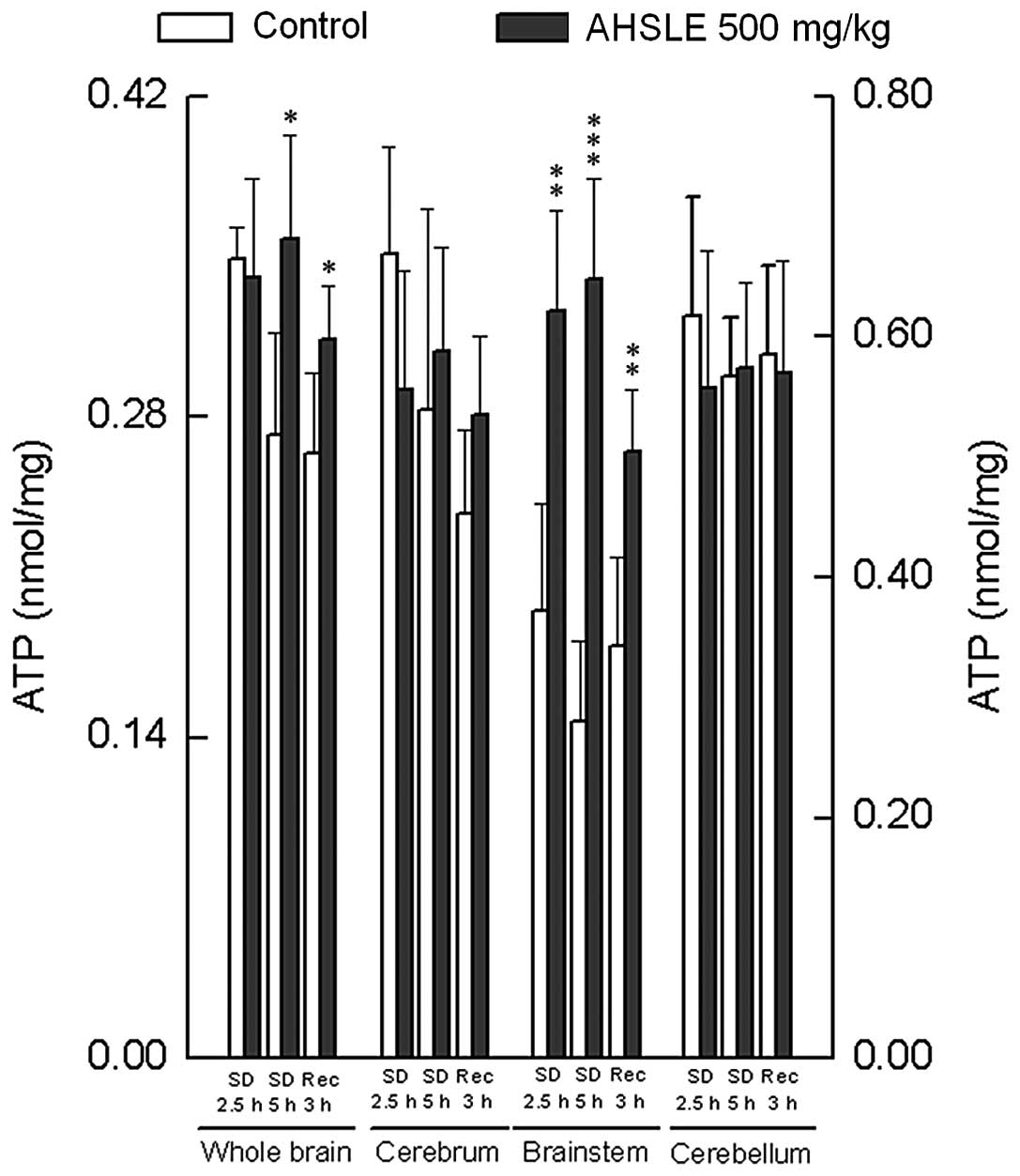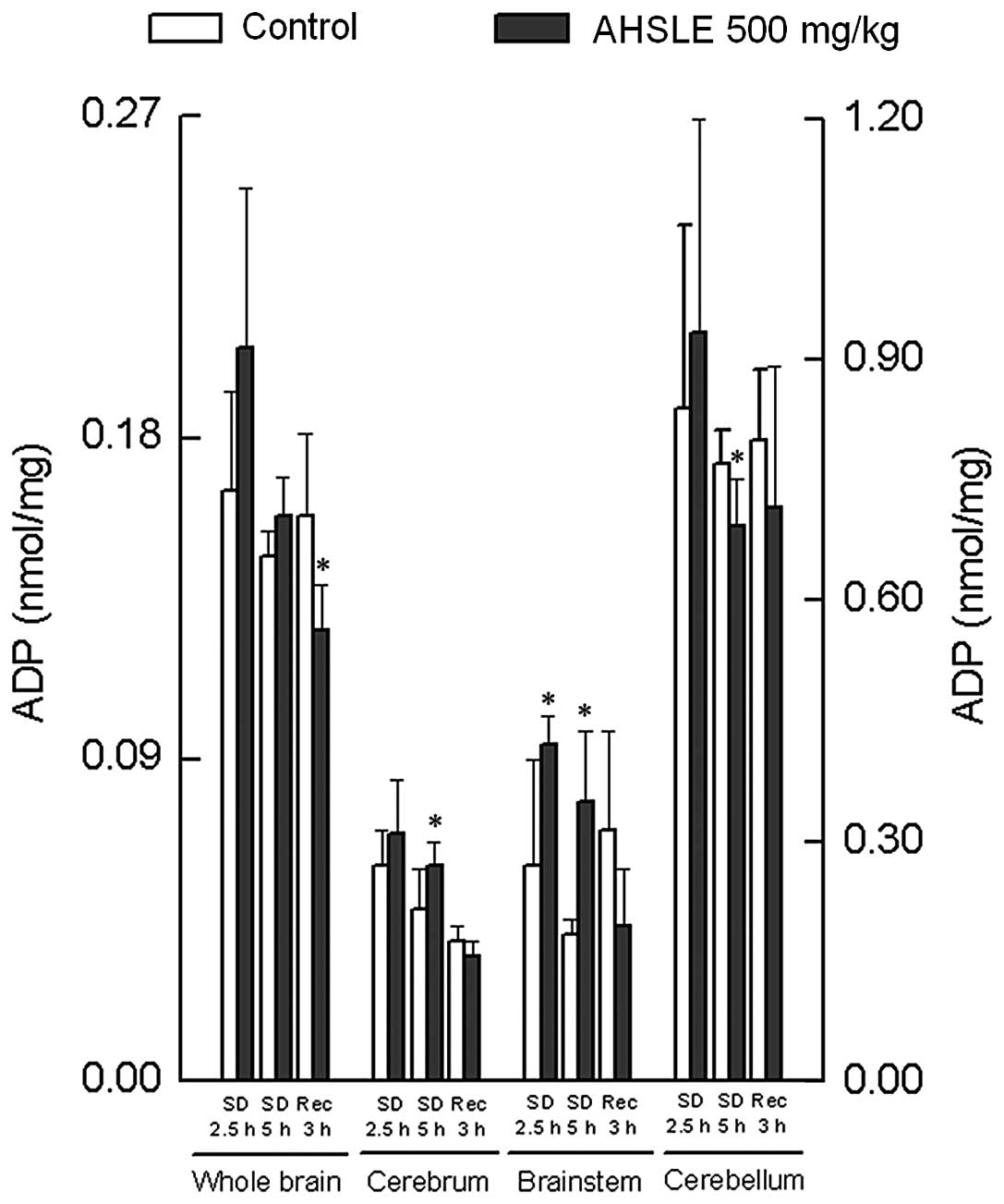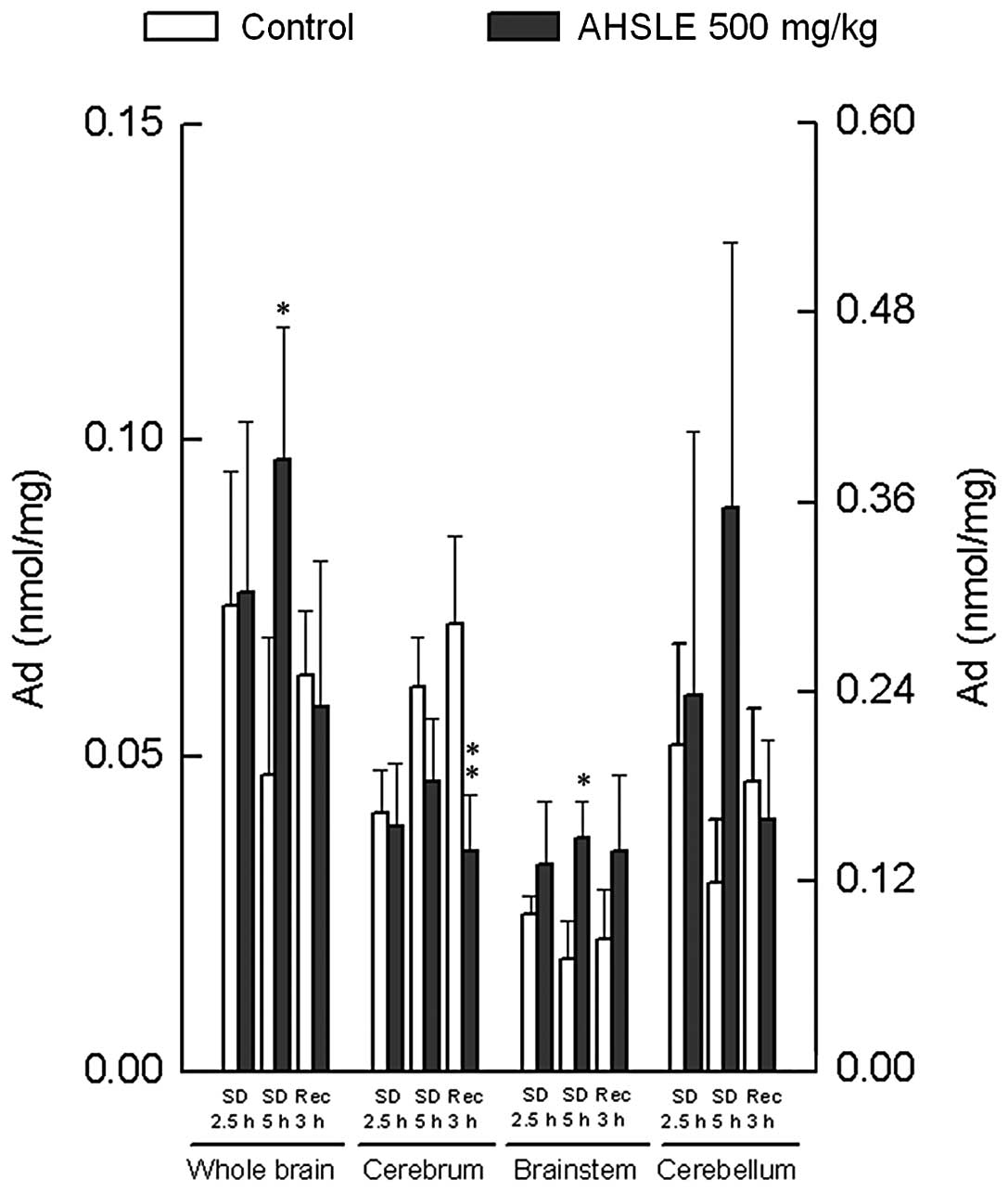|
1.
|
Wang QC, Xu J, Shi M, et al: Clinical
observation of preparation from the branch and leaf of peanut in
treating insomnia. Shanghai J Trad Chin Med. 5:8–10. 2001.(In
Chinese).
|
|
2.
|
Hu PF, Fan RP, Li YP and Pang CY: Studies
on pharmacological action of Luohuashengzhiye extract. Chin Trad
Pat Med. 23:919–920. 2001.(In Chinese).
|
|
3.
|
Wang YF, Li HF, Xu YF, Zhang YL, Xu DS,
Xiao LM and Li XM: Clinical confirmation of preparation from the
branch and leaf of peanut in treating insomnia. Shanghai J Trad
Chin Med. 5:11–14. 2001.(In Chinese).
|
|
4.
|
Zu XY, Zhang ZY, Liu JQ, Hu HH, Xing GQ,
Zhang Y and Guan D: Sedative effects of peanut (Arachis
hypogaea L) leaf aqueous extracts on brain ATP AMP, adenosine
and glutamate/GABA of rats. J Biomed Sci Eng. 3:268–273. 2010.
|
|
5.
|
Sherin JE, Shiromani PJ, McCarley RW and
Saper CB: Activation of ventrolateral preoptic neurons during
sleep. Science. 271:216–219. 1996. View Article : Google Scholar : PubMed/NCBI
|
|
6.
|
Gaus SE, Strecker RE, Tate BA, Parker RA
and Saper CB: Ventrolateral preoptic nucleus contains sleep-active
galaninergic neurons in multiple mammalian species. Neuroscience.
115:285–294. 2002. View Article : Google Scholar : PubMed/NCBI
|
|
7.
|
Sherin JE, Elmquist JK, Torrealba F and
Saper CB: Innervation of histaminergic tuberomammillary neurons by
GABAergic and galaninergic neurons in the ventrolateral preoptic
nucleus of the rat. J Neurosci. 18:4705–4721. 1998.PubMed/NCBI
|
|
8.
|
Wigren HK, Schepens M, Matto V, Stenberg D
and Porkka-Heiskanen T: Glutamatergic stimulation of the basal
forebrain elevates extracellular adenosine and increases the
subsequent sleep. Neuroscience. 147:811–823. 2007. View Article : Google Scholar : PubMed/NCBI
|
|
9.
|
Franken P, Dijk DJ, Tobler I and Borbély
AA: Sleep deprivation in rats: effects on EEG power spectra,
vigilance states, and cortical temperature. Am J Physiol.
261:R198–R208. 1991.PubMed/NCBI
|
|
10.
|
Schweinsberg PD and Loo TL: Simultaneous
analysis of ATP, ADP, AMP, and other purines in human erythrocytes
by high-performance liquid chromatography. J Chromatogr.
181:103–107. 1980. View Article : Google Scholar : PubMed/NCBI
|
|
11.
|
Dworak M, Diel P, Voss S, Hollmann WK and
Strüder H: Intense exercise increases adenosine concentrations in
rat brain: implications for a homeostatic sleep drive.
Neuroscience. 150:789–795. 2007. View Article : Google Scholar : PubMed/NCBI
|
|
12.
|
Thakkar MM, Engemann SC, Walsh KM and
Sahota PK: Adenosine and the homeostatic control of sleep: effects
of A1 receptor blockade in the perifornical lateral hypothalamus on
sleep-wakefulness. Neuroscience. 153:875–880. 2008. View Article : Google Scholar : PubMed/NCBI
|
|
13.
|
Huang ZL, Urade Y and Hayaishi O:
Prostaglandins and adenosine in the regulation of sleep and
wakefulness. Curr Opin Pharmacol. 7:33–38. 2007. View Article : Google Scholar : PubMed/NCBI
|
|
14.
|
Kalinchuk AV, Urrila AS, Alanko L,
Heiskanen S, Wigren HK, Suomela M, Stenberg D and Porkka-Heiskanen
T: Local energy depletion in the basal forebrain increases sleep.
Eur J Neurosci. 17:863–869. 2003. View Article : Google Scholar : PubMed/NCBI
|
|
15.
|
Ticho SR and Radulovacki M: Role of
adenosine in sleep and temperature regulation in the preoptic area
of rats. Pharmacol Biochem Behav. 40:33–40. 1991. View Article : Google Scholar : PubMed/NCBI
|
|
16.
|
Radulovacki M: Role of adenosine in sleep
in rats. Rev Clin Basic Pharm. 5:327–339. 1985.
|
|
17.
|
Van Wylen DG, Park TS, Rubio R and Berne
RM: Increases in cerebral interstitial fluid adenosine
concentration during hypoxia local potassium infusion and ischemia.
J Cereb Blood Flow Metab. 6:522–528. 1986.PubMed/NCBI
|
|
18.
|
Jalali Heravi M and Sereshti H:
Determination of essential oil components of Artemisia
haussknechtii Boiss. using simultaneous
hydrodistillation-static headspace liquid phase microextractiongas
chromatography mass spectrometry. J Chromatogr A. 1160:81–89.
2007.PubMed/NCBI
|
|
19.
|
Letizia CS, Cocchiara J, Lalko J and Api
AM: Fragrance material review on linalool. Food Chem Toxicol.
41:943–964. 2003. View Article : Google Scholar : PubMed/NCBI
|
|
20.
|
Simić A, Soković MD, Ristić M,
Grujić-Jovanović S, Vukojević J and Marin PD: The chemical
composition of some Lauraceae essential oils and their
antifungal activities. Phytother Res. 18:713–717. 2004.
|
|
21.
|
Guzmán-Gutiérrez SL, Gómez-Cansino R,
García-Zebadúa JC, Jiménez-Pérez NC and Reyes-Chilpa R:
Antidepressant activity of Litsea glaucescens essential oil:
identification of β-pinene and linalool as active principles. J
Ethnopharmacol. 143:673–679. 2012.
|
|
22.
|
de Almeida RN, Araújo DA, Gonçalves JC,
Montenegro FC, de Sousa DP, Leite JR, Mattei R, Benedito MA, de
Carvalho JG, Cruz JS and Maia JG: Rosewood oil induces sedation and
inhibits compound action potential in rodents. J Ethnopharmacol.
124:440–443. 2009.PubMed/NCBI
|

















